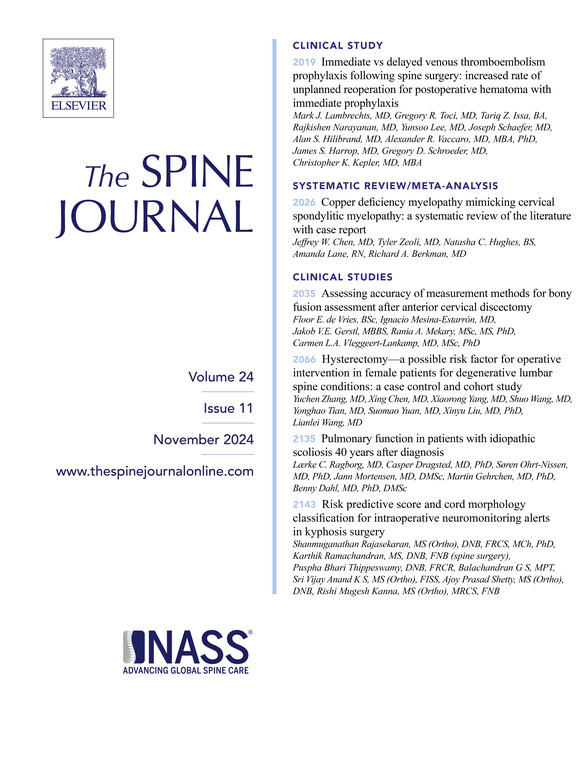Complications and health-related quality of life following lumbosacral hemivertebra resection and short segmental fusion: a retrospective cohort study
IF 4.9
1区 医学
Q1 CLINICAL NEUROLOGY
引用次数: 0
Abstract
BACKGROUND CONTEXT
Previous literature has provided descriptions of postoperative complications. However, these studies have included heterogeneous cohorts of hemivertebra patients undergoing different surgical methods and addressing deformities at various locations.
PURPOSE
To assess independent risk factors for complications following lumbosacral hemivertebra (LSHV) resection and to further explored the potential association between complications and health-related quality of life (HRQOL).
DESIGN
Retrospective cohort study.
PATIENT SAMPLE
We retrospectively analyzed consecutive patients who underwent LSHV resection and short segment fusion at our institution between 2010 and 2022.
OUTCOME MEASURE
In the current study, the outcome measure were complications and HRQOL.
METHODS
Between 2010 and 2022, a total of 64 consecutive patients with LSHV underwent hemivertebra resection. The diagnostic criteria for LSHV were delineated that the hemivertebra resides caudal to L5 and beyond. Electronic patient record and radiographic data were reviewed retrospectively in our electronic database. According to complications, the patients were divided into with and without complications, and further stratified as neurological, mechanical, and infectious complications. HRQOL outcomes were collected preoperatively, 3 months postoperatively, and at last follow-up using the Scoliosis Research Society-22 (SRS-22) questionnaire. Multivariate logistic regression models were used to determine independent risk factors affecting complications.
RESULTS
A total of 64 patients were enrolled in this study for at least 2-year follow-up. The mean follow-up was 7.3±4.2 years. In the coronal plane, the mean main curve was corrected from 27.3° preoperatively to 8.0° postoperatively, and 9.3° at last follow-up. Global spine balance was significantly improved after surgery, and kept stable during the follow-up. In all, 18 complications were recorded in 15 (23.4%) patients. In the multivariate logistic regression model, 3 independent risk factors for complication were screened out, including age (OR=1.16, 95% CI 1.01–1.34, p=.042), anterior reconstruction (OR=3.40, 95% CI 1.03–11.2, p=.045), and preoperative CB (OR=1.06, 95% CI 1.00–1.12, p=.036). The mean SRS-22 total and domain scores for the entire cohort showed improvement at last follow-up. However, in the noncomplication group, the improvements in SRS-22 scores were more substantial.
CONCLUSION
Postoperative neurological and mechanical complications are common medical events following LSHV resection. The age, anterior column reconstruction, and preoperative coronal balance were the independent risk factors. Compared to the noncomplication group, the improvements in HRQOL are blunted in the complication group.
腰骶椎半椎体切除术和短节段融合术后并发症和与健康相关的生活质量:回顾性队列研究
背景情况:以往的文献对术后并发症进行了描述。目的:评估腰骶半椎体(LSHV)切除术后并发症的独立风险因素,并进一步探讨并发症与健康相关生活质量(HRQOL)之间的潜在关联:设计:回顾性队列研究:我们回顾性分析了2010年至2022年间在我院接受LSHV切除术和短节段融合术的连续患者:2010年至2022年间,共有64例LSHV患者接受了半椎体切除术。LSHV的诊断标准为半椎体位于L5尾部及以上。我们在电子数据库中对患者的电子病历和影像学数据进行了回顾性审查。根据并发症将患者分为有并发症和无并发症两类,并进一步分为神经系统并发症、机械性并发症和感染性并发症。我们使用脊柱侧凸研究学会-22(SRS-22)问卷收集了患者术前、术后3个月和最后一次随访的HRQOL结果。采用多变量逻辑回归模型确定影响并发症的独立风险因素:共有64名患者参与了这项研究,并接受了至少2年的随访。平均随访时间为(7.3±4.2)年。在冠状面上,平均主曲线从术前的27.3°矫正到术后的8.0°,最后一次随访时为9.3°。术后脊柱的整体平衡得到明显改善,并在随访期间保持稳定。共有 15 名患者(23.4%)出现了 18 种并发症。在多变量逻辑回归模型中,筛选出了三个独立的并发症风险因素,包括年龄(OR=1.16,95% CI 1.01-1.34,P=0.042)、前路重建(OR=3.40,95% CI 1.03-11.2,P=0.045)和术前 CB(OR=1.06,95% CI 1.00-1.12,P=0.036)。最后一次随访时,整个组群的 SRS-22 总分和领域平均分均有所改善。然而,在无并发症组中,SRS-22评分的改善幅度更大:结论:术后神经和机械并发症是LSHV切除术后常见的医疗事件。结论:术后神经和机械并发症是 LSHV 切除术后常见的医疗事件,年龄、前柱重建和术前冠状面平衡是独立的风险因素。与非并发症组相比,并发症组患者的 HRQOL 改善程度减弱。
本文章由计算机程序翻译,如有差异,请以英文原文为准。
求助全文
约1分钟内获得全文
求助全文
来源期刊

Spine Journal
医学-临床神经学
CiteScore
8.20
自引率
6.70%
发文量
680
审稿时长
13.1 weeks
期刊介绍:
The Spine Journal, the official journal of the North American Spine Society, is an international and multidisciplinary journal that publishes original, peer-reviewed articles on research and treatment related to the spine and spine care, including basic science and clinical investigations. It is a condition of publication that manuscripts submitted to The Spine Journal have not been published, and will not be simultaneously submitted or published elsewhere. The Spine Journal also publishes major reviews of specific topics by acknowledged authorities, technical notes, teaching editorials, and other special features, Letters to the Editor-in-Chief are encouraged.
 求助内容:
求助内容: 应助结果提醒方式:
应助结果提醒方式:


